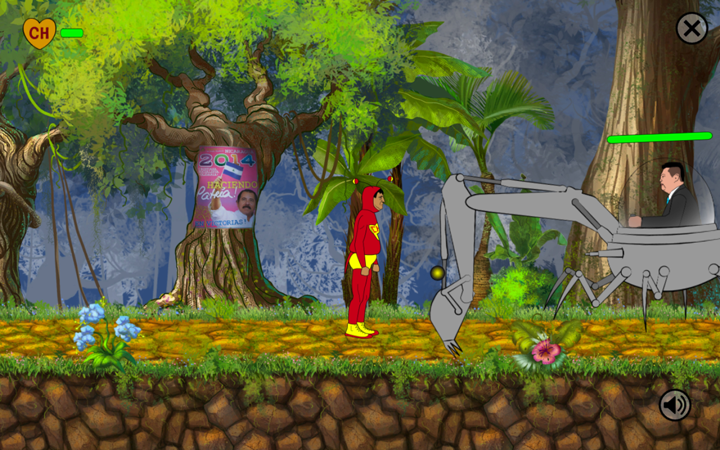Archive for the ‘New Media’ Category
Chasing Bits a Web Platformer Game

“No Media” is an online exhibition featuring art work entirely made from code. This means no media files – no jpg or gif or png or mp3 or wav or mp4 or webm or any type of self-contained file type. When I was invited to participate in this exhibition, it was a tricky proposition for me as I’m primarily a visual artist who uses software and generally when I code it’s in an environment such as Visual Studio with Unity. My web projects tend to include SVGs created in Illustrator or video or audio files… But I greatly appreciated the invitation and the challenge to work differently. However, I’m not a good coder, generally, I hack things together or review endless tutorials. In grad school at Carnegie Mellon University, I was allowed to enroll in the Computer Science intro to programming undergraduate course. This is a course designed to weed out those who will not go on to become programmers; I lasted three weeks.
I regularly use javascript, the language of the web, I wanted to make something that would be fun for people to interact with and I had been researching digital currencies for the last couple of years for another project. Since I was 11 years old, I’ve loved platformers due to my initiation as Activision’s Pitfall Harry in 1982. So I decided to take Marijn Haverbeke‘s entirely code-based javascript platformer game covered in his book Eloquent Javascript and inject it with a bit of Bitcoin and alt coin content. I feel that the platformer presents the ideal game metaphor for the dreams and pitfalls of alt coins. The game titled Chasing Bits has audio, but it’s the browser’s speech synthesis that reads a hidden text (no media). And there are emojis that may appear to be image files, but are also bits of code. (It’s probably time to add the death emoji.). There is one live data feed – the current value of Bitcoin which you may update throughout the game.
Since web audio generally requires a user event, players must click a button to trigger the browsers reading of the following passage:
What happens when a utopian idea for a decentralized currency gains adoption in the midst of hypercapitalism? Speculative investors looking to get rich quick, loose. The early bird gets the worm, the rest just dig for fools gold. Or perhaps the current value of bitcoin will triple and you head straight to the Cayman Islands to sip on rum and coke as you lazily sway in a hammock between shade and sunlight.
Unfortunately it is 2022, the U.S. government slowed the printing of free money, inflation has risen, uncertainty has set in and the happy go lucky period of Bitcoin and alt coins has taken a pause. Sit tight, wait 10 years and just maybe those Ethereum coins will be worth eighty thousand each! Or perhaps, the Financial Action Task Force may just clamp down and regulate Bitcoin and digital currencies due to money laundering and other criminal use of digital currencies. No one knows what lays ahead. So meanwhile, why not chase those bits…
I can not afford real property, so I buy land in the metaverse. I like going there in the evenings when I sit alone and wonder when others will join. Perhaps I will rent out some space and make more bits. However, I don’t like it when the earth quakes.
As soon as Bitcoin peaks again, I will buy a pig to store clones of all my primary organs, this way I will double my life span and live to a 180 and by then I will own a country in the meta verse and deliver my own currency. My anti gravity suit will keep me looking young. Meanwhile I will continue chasing bits.
Try the Chasing Bits, listen to that audio, check the current value of Bitcoin, I hope you are mildly entertained!
NFS NSFW NFT Exhibition Is Live!
NFS NSFW NFT is a 3D virtual exhibition produced by members of NEW INC and Rhizome’s Art & Code track. The exhibition is on New Art City, hosting a Zoom opening, minting a NFT on Foundation, and closing with a panel at Hunter College — all, to explore the critical poetics of this particular not-for-sale, not-safe-for-work, and non-fungible-token moment. The exhibition is composed of three galleries:
The NFS garden is skinned with cryptocurrency symbols and animations. Featuring work from Ricardo Miranda Zúñiga, Mark Ramos, and Bhavik Singh.
The NSFW garden is skinned with community rules and blurred graphics that platforms use to police adult content. Featuring work from Itziar Barrio, Christopher Clary, Nahee Kim, and Pearlyn Lii.
The NFT garden is skinned with graphics that corporations use to illustrate the blockchain. Featuring work from Johanna Flato, Lula Mebrahtu, Yeseul Song, and Ziyang Wu.
I contributed two works – a mock real estate advertisement and a sphere skinned with crypto logos that houses an audio file.
I created the real estate video advertisement featuring actress Sajda Waite for a desktop and virtual reality app titled Desplazados. Desplazados is a wandering world application set in a 19th century tenement neighborhood. One explores the environment populated by disembodied voices that share observations and personal stories regarding urban gentrification and dislocation. The voices are street interviews that I conducted as the 1 billion dollar development Essex Crossing broke ground. As one spends time with Desplazados, old buildings explode and new glass towers rise. By the end of the 20 minute experience, one is surrounded by glass skyscrapers. The video advertisement is one of two scripted elements in the app.
The crypto sphere presents logos of some of the more prominent crypto or alt currencies. When one enters the sphere, you hear a snippet of a conversation with artist Grayson Earle who created Bail Bloc, a blockchain app that when running on one’s computer generates funds for the Immigrant Bail Fund of New Haven CT that aids immigrants detained by ICE. The interview is part of a project I’ve been working on over the past year titled FinTech for the Precariat that investigates the effects of emerging financial technologies. As with Desplazados the project is a desktop and VR app that will feature 12 interviews with artists, financial specialists and individuals who have been living in financial distress.
Both these projects question speculative commerce and investing and the disparity and distress that the financialization of human existence causes.
Lindsay Howard wrote an inspiring essay regarding web3 and the possibilities of decentralized currencies and collective action. Written in a manifesto style that condemns the exploitative nature of web2.0 social network corporations, the essay is titled “Innovative Economies.”
The Golden Age of FinTech

FinTech for the Precariat (working title) is a net art work that speculates on the false promises of income distribution in the Age of Bezos. COVID-19 has compounded existential insecurity; the pandemic of stress has been inseminated by the novel flu virus to birth a new reality – a chasm of uncertainty. As unemployment soars, speculative futures drive a stock market that has largely rebounded from the initial shock, but on what basis? The basis that this moment will soon pass and the age of plutocrats, technocrats and authoritarianism will continue thriving a year from now; the slight disruption soon forgotten. The agenda of economic growth must be embraced at the cost of human health. After all, those who enjoy the economic growth will remain safely at home in their condo or rural cabin or yacht.
It has been projected that the 2020s will be the decade of the FinTech Revolution. This marketing hyperbole is on the heels of many such revolutions – the Green Revolution, the Personal Computing Revolution, the dot.com, web2.0 and Social Network Revolution… These revolutions are sold on the promises of democratization and wealth. And they always leave a toll from cancer and the privatization of agriculture to unparalleled surveillance. Today financial technologies present the promise of democratizing complicated transactions, facilitating personal banking, mass speculation in stocks… Whether budgeting or gambling, these tools are relatively harmless. However, entirely new finance mechanisms or rather schemes are being developed as part of FinTech including autonomous finance, bitcoin and ultimately the financialization of human existence. A sector of FinTech will compound income inequality nationally and globally to insurmountable levels. As made abundantly clear by world leaders, finance no longer serves humanity, humanity serves finance.
Question of Intelligence
Before COVID-19 shutdown New York City, I had the opportunity to experience the exhibition “The Question of Intelligence – AI and the Future of Humanity” curated by Christiane Paul at Parson’s Kellen Gallery. I did not enter the exhibition expecting to witness disparate algorithms animating the exhibition space. It took me a few minutes to realize that the empty gallery (populated only by myself and two silent gallery sitters busily working, I suppose, on their school work) was brought to life by artworks forced to listen to one another and respond. I’m talking about artworks sensing via microphones, cameras, the internet; processing through artificial intelligence, machine learning, algorithms; and communicating via speakers, projectors, screens, printers, the internet and miniature swamps.
Christiane Paul has assembled elder artificial intelligence artworks over 40 years old (though still learning) with nascent works just starting to realize themselves. With the popular explosion of catch phrases including “Big Data,” “AI,” “Machine Learning,” “Today, right now, you have more power at your finger tips than entire generations that came before you…” (I used to appreciate Common before the Microsoft commercial, now I cringe when I hear his voice), Paul has curated a learning experience that recognizes the generational history of artificial intelligence as a creative medium.
Upon entering the gallery, one hears female artificial voices generating poetry or relating temperatures and soil humidity and other environmental measures or in the distance an occasional tweet. To the left, I saw a big black microphone and elected to approach it as the first means toward interactivity. I introduced myself and then watched my words projected onto the wall along with Chinese-style landscape paintings. Trails are drawn from word groupings to word groupings along with drawn landscapes and icons forming a word and image map. The projection is a mind map generator based on the words captured by the microphone. Following a few phrases, I decided it wasn’t very interesting and decided to move on. Adjacent to it is Lynn Hershman Leeson’s chatbot Agent Ruby (2001), but having interacted with one of Leeson’s works at Yerba Buena’s “The Body Electric” recently, I only spent a minute with it before moving on, also it didn’t know what to make of what I was telling it.

Adjacent to the chatbot, is Lior Zalmanson’s “image may contain” in which the artist feeds historically significant images into FaceBook’s Automatic Alternative Text image recognition algorithm, an accessibility AI to help contextualize images for the blind and sight impaired. The artists uses the uncontextualized and minimal description of the historical images to identify “similar” images and then collapses them onto lenticular prints. Above are the images that appear in the first print as I move from left to right. The work simply and clearly shows that bots such as AAT should not be used to present information and least of all pretend to be a source of knowledge, at least not yet.
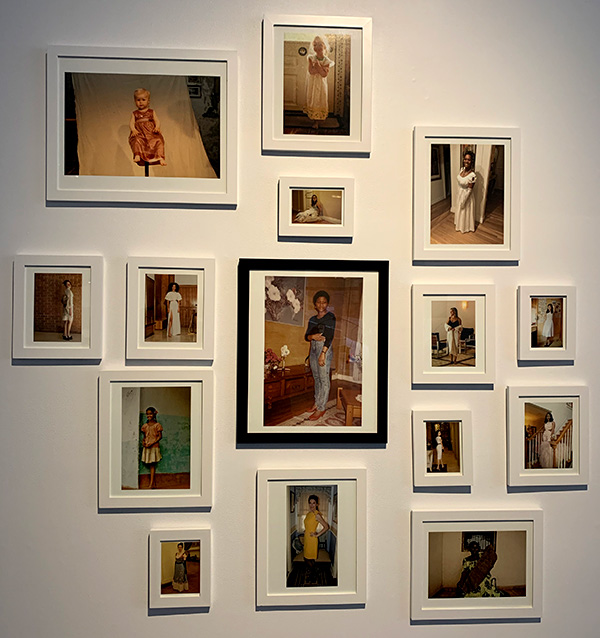
Similarly, Mimi Onuoha uploaded a photo of her mother “to Google’s reverse image search, which allows one to upload a picture to find online images that the Google algorithms identify as related.” Scaled, printed and framed from the initial image at the center to the algorithmically related images encircling, a seemingly family home portrait wall appears, leading one to question the process of algorithmic categorization based entirely on visual similarity. With such a project, I can’t help but recall eugenics and Sekula’s “The Body and the Archive.”
I then circled back toward the center of the gallery to try and figure out what was going on with “The Giver of Names” by David Rokeby. And it wasn’t until I read the instructions and changed the objects on the pedestal to assemble my own still life that the brilliance of the exhibition really dawned on me!
“The Giver of Names” (naming since 1990) consists of a monitor, speaker, old CCTV camera, pedestal, pile of old toys and a program that tries to understand what it is seeing through the camera to generate poetry. Once I removed the toys left on the pedestal and placed my own selection, I watched the AI go into action by identifying shapes and colors and then trying to make sense of what it was identifying or “seeing.” Those shapes and colors feed a poetry algorithm that speaks and writes to the monitor adjacent to the CCTV camera. Meanwhile, just beyond this installation, the not very interesting mind mapping microphone is also capturing this generated poetry as it echoes across the gallery and starts mind mapping away. AWESOME! The gallery is its own loop of machines churning away at one another’s utterances. This realization helped me refocus my attention and expand my time with each work. I tried to capture this in the video at the top of this entry.
Near the entrance on a wall monitor, hangs AARON which I had merely paused at for a few seconds but now returned to observe. “AARON is the earliest artificial intelligence program for artmaking and one of the longest running ongoing projects in contemporary art. Harold Cohen started creating AARON at UCSD in the late 1960s and developed the software until his death in 2016. In this video AARON produces a new color image every 10 to 15 minutes.” As one tours the gallery, AARON is quietly working away creating shapes and lines of color, artful abstractions.
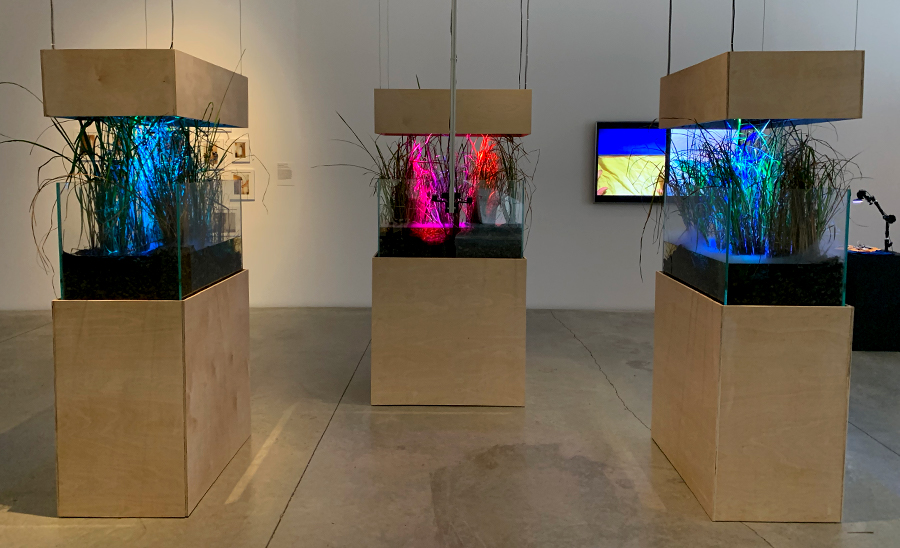
Back near the center of the gallery, just beyond “The Giver of Names” is another work with a female computer voice speaking at intervals. Tega Brain’s “Deep Swamp” asks “if new ‘wilderness’ is the absence of explicit human intervention, what would it mean to have autonomous computational systems sustain wild places?” The handsome installation has three AIs, Nicholas, Hans and Harrison each “engineer their environment for different goals. Harrison aims for a natural looking wetland, Hans is trying to produce a work of art and Nicholas simply wants attention.”
“Learning to See” by Memo Akten uses machine learning to relate the objects on a pedestal that a camera captures to five different data sets that the system has been fed. The visitor can re-arrange the objects on the pedestal to see new interpretations. Across from the pedestal on a wall is a split screen that shows the image captured by the camera adjacent to the system’s interpretation. “Every 30 seconds the scene changes between different networks trained on five different datasets: ocean and waves, clouds and sky, fire and flowers, and images from the Hubble Space telescope.
Similarly across the gallery, hang a series of prints by Mary Flanagan. The work is [Grace:AI] in which generative algorithms trained on thousands of paintings and drawings by women to create a series of images. “[Grace:AI] was tasked to create her ‘origin story’ by looking at 20,000 online images of Frankenstein’s monster and producing its portrait.”
Both “Learning to See” and “[Grace:AI]” employ generative adversarial networks (GAN), to generate new visualizations. Using GAN anyone can put their own conceptual spin to generate a data set for the machine to learn and see what it spits out. Over the last few years, I’ve seen a few similar projects, my favorite remains an early one – the MEOW Generator trained on a cat dataset.
Perhaps the most darkly monumental project are the large four black machines with spinning fans, exuding steam and ticker tape – the installation component of #BitSoil Tax by LarbitsSisters. The project proposes the fair redistribution of internet wealth to all people through a new taxation system. The installation is utopian, dark and whimsical.
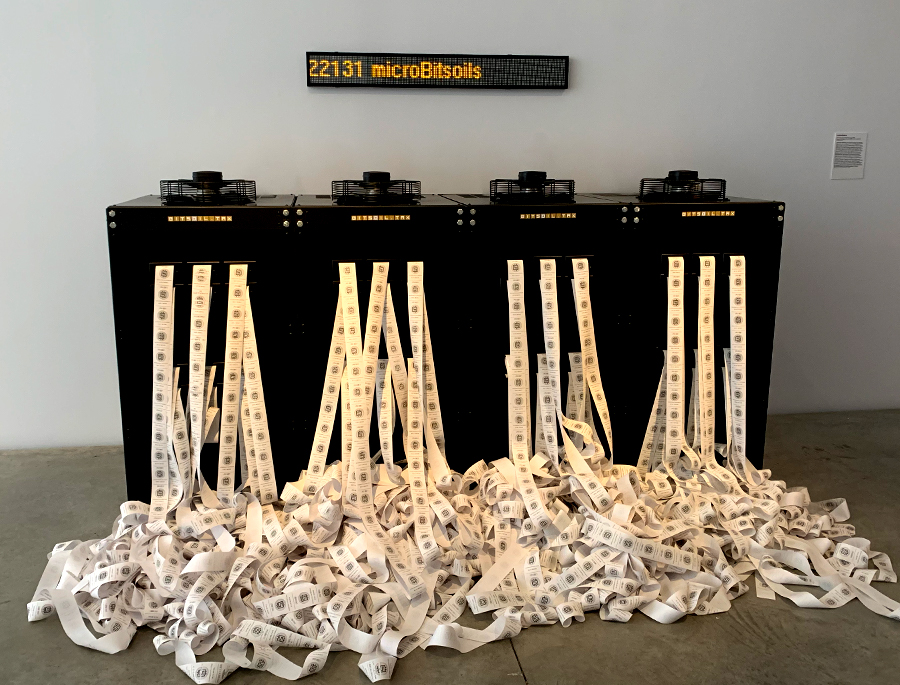
Other projects on exhibit include “Futures of Work” by Brett Wallace, and Ken Goldberg and the AlphaGarden Collective.
Realidad VE
Realidad VE is a small experiment that attempts to combine documentary material with virtual space for VR presentation.
Last fall I had an extended interview with José Bergher a retired professor and classically trained musician from Venezuela who was the director of the Symphony Orchestra of Venezuela. Throughout his professional career he worked between New York City and Caracas and the reason behind the interview was to learn about that dual citizenry – about living between cultures and floating from one part of the world to the other. However as the interview progressed, I asked José about the current state of Venezuela – politically, economically and the common problems that people face day to day. He replied with a 20 minute discussion of the rise of Chavez and the current power-grab by Maduro and the lasting influence of Fidel Castro.
I knew that this discussion would not be appropriate for the project that I was working on, but I appreciate his first-hand perspective and given the last several weeks in Venezuela, I wanted to present his voice in a unique format. Entirely based on my news consumption of current protests, clashes and seemingly general instability in Venezuela, I created a blank world with the exception of dead trees and abandoned drilling rigs. The world is populated by men and women running across the space. A boy sits against a tree taking in the world around him. At another spot a young couple argues and elsewhere two friends are in discussion. Along the entire perimeter paramilitary troops stand guard and watch the space. At a couple spots trios of soldiers have friendly discussions. In this world, the military is at ease, though watchful whereas the people appear frantic.
I’m interested in combining documentary material such as the interview with José Bergher with virtual space and employing virtual reality as a platform for documentary. Jose’s discussion of current Venezuelan politics presented an opportunity for experimentation. Pictured above is the project for installation that features an animated José Bergher above the virtual space, the project is online with out Bergher’s video, only his voice accompanies the virtual space as the inclusion of video made an already long load time much longer.
Defend Net Neutrality
Net Neutrality is the principle that Internet service providers should enable access to all content and applications regardless of the source, and without favoring or blocking particular products or websites. SUBMIT A LETTER TO THE FCC.
Trump appointed US Federal Communication Commission (FCC) chairman Ajit Pai has spearheaded an FCC vote to end net neutrality rules. It was just in 2015 that the FCC with support of the Obama administration introduced new net neutrality regulations that put internet service providers (ISPs) such as Verizon, Comcast, AT&T in the same category as other telecommunication companies. ISPs currently are not allowed to favor the speed of some sites over others, all data on the internet moves at the same speed.
The FCC was first created to protect radio from commercialization and to ensure that it remain a public service. Given that on FM non-commercial stations have been shoved to one side in favor of powerful commercial media corporations, it seems merely a matter of time that the same occurs to the internet. However, perhaps at least for now, due to the nature of the internet as a social medium, net neutrality may be temporarily protected. Since the Clinton administration, the FCC has favored deregulation and corporate monopolization of the media, can this course of increasing corporate control of our media content and in general our culture be slowed down? SUBMIT A LETTER TO THE FCC.
“Hansel & Gretel” at Park Avenue Armory – Save Your Money

The “Hansel & Gretel” curatorial statement describes the installation as a space that brings together Jacques Herzog, Pierre de Meuron and Ai Weiwei combined interests in
the psychological impact of architecture and the politics of public space; creating a playful, strange, and eventually eerie environment with different layers of reality revealed to the visitor… Hansel & Gretel is a dystopian forest of projected light where the floor rises up, as if lifted by an invisible force, and visitors are tracked by infrared cameras and surveyed by overhead drones as they systematically capture the parkgoers’ data and movements…
Unfortunately, the only portion of this description that resonates is the playfulness. Indeed Herzog, de Meuron and Weiwei have created a dark environment in which visitors may skip around and play with light traces of their image. However, the installation lacks strangeness, eeriness, politics or any psychological reverberation.
Other than the initial moment of discovery that one’s image is being projected on to the ground after it is periodically taken due to on one’s movement in the space, the installation presents very little that is interesting. The drones may have been a neat prop had they not been tethered.
The second part of the installation is a didactic revelation of what the installation is trying to allude to – that we are objects of surveillance. As far as a critical art installation regarding surveillance, there was much more interesting work done 15+ years ago. Perhaps the theme of surveillance has been so overly investigated and picked apart by art previously and by entertainment today (“Black Mirror” for example) that such an installation seems trite and naive. There is so much of our data being captured today, that building an installation that merely plays upon facial recognition and motion sensors is just kind of dumb, but it is playful. So if $16 is worth the cost of running around a huge dark open space and playing with light projection, check it out.
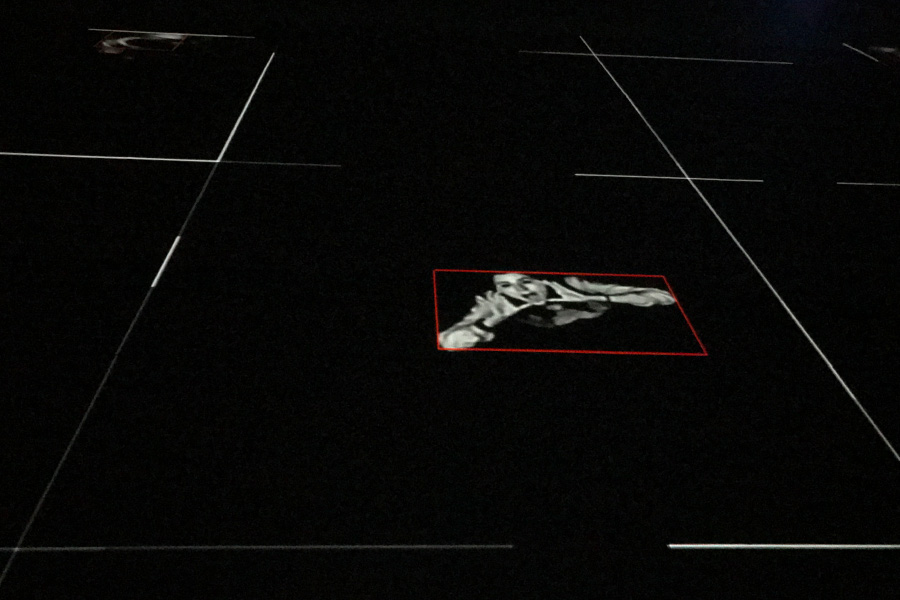
A second perspective: Playtime at the Armory
Once again discovering what this city has to offer, there I was with Ricardo walking into a venue called the Armory near Hunter College, a place I had never been before to see a new art installation called “Hansel & Gretel”. He had been keen to check this out for a few weeks, and like the curious creature I am, I followed along.
We received a quick intro and were instructed to read a phase on the wall before entering -which i forgot- and then allowed to enter. We walked into black nothingness. My immediate reaction was to scramble for Ricardo’s hand. I didn’t realize the massiveness of this place until my eyes adjusted from the summer sunlight to the darkness inside of the Armory. It was only eerie the first few minutes because I had no idea where the hell I was walking. There were a few cameras far above us hanging from the ceiling and lights that would follow us. As we continued to walk, our movement was detected, grid lines would appear and cameras would be activated to capture our moves. Suddenly, it was playtime! It was fun to pose in different positions to watch the resulting snap shot of yourself illuminated on the black floor. At one point my sweater and shoes came off and I really got into it.
Ricardo noticed two drones hovering on one side of the space living poor unfulfilled lives- tied onto leashes without free movement. It would have been more interesting if they were chasing people around. After exhausting our ideas for poses, the novelty wore off and we were ready to enter part deux of the installation. For that, we had to exit this part of the Armory and enter from another entrance on the other side of the street.
After pausing in front of a camera you were allowed inside. There were many ipads on long tables with apps. You could elect to have your face identified and then search the cameras for your photo which was taken in the first part of the installation. That was cool. You could read about the history of surveillance, or access cameras to spy on others walking into the exhibits. The Armory itself was impressive, the installation not as much. It was a new, interesting experience- a fun activity for kids, I would say. I didn’t leave with the feeling that I had witnessed an impressive statement against today’s constant scrutiny and monitoring that we are all under. I didn’t feel intruded upon. There wasn’t anything menacing or fantastical as is described in the program leaflet. It was just pretty cool and fun.
Perhaps the work behind the installation was complicated, but with my lack of technical know-how, I failed to appreciate the amount of effort involved. To have truly made an impact, more could have been done to confuse or play with the audience with the intention of throwing them off or perhaps even scaring them. Coupling that with the sound of Russian men having conversations in the background (that felt clandestine in nature), and I would have possibly left quite feeling differently.
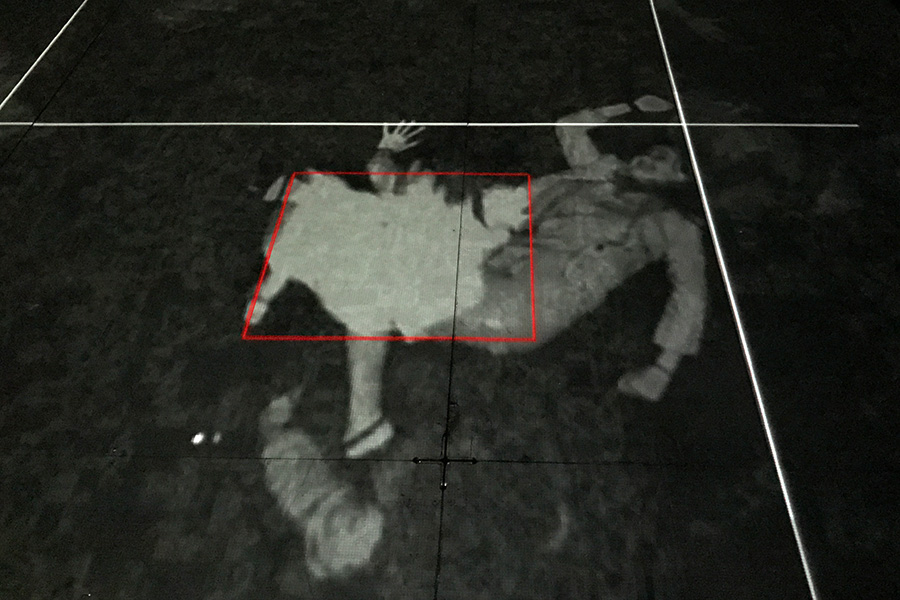
Reflections on “Arlington”
Imagine a sterile white waiting room with a row of three plastic blue chairs to the far left and a tall narrow window to the far right. At the back, to the right is a wide fish-less aquarium, to the right of the aquarium on the wall a paper cup dispenser and nearly at the right corner the only door to enter or leave the waiting room. It is a narrow and tall door. On the drop ceiling are four surveillance cameras and mounted on to the wall behind the plastic chairs a microphone on a gooseneck. On the other side of that left wall, is a control room with a desk and many small monitors all about the room.
In Enda Walsh’s “Arlington” the waiting room is at once an isolation room and an observation room but more importantly a psychological prison. I went to the play (currently at St. Ann’s Warehouse) because I was interested in seeing how the piece melded multimedia with the actors on the stage as I had read it was quite successful; I was not disappointed.
The play that combines theater, dance, video, music and lighting effects to create a work of speculative fiction that delves in to existential reality based in contemporary, first-world society. Initially the play brought to mind Calderón de la Barca’s “La vida es sueño” (Life Is a Dream) (1635) – “Man dreams what he is until he awakens…” I read the play over 20 years ago and what I recall is that a prince, Segismundo is imprisoned in a windowless tower since his childhood. He is given a tutor to have a formal education. When he dreams he recalls his life before imprisonment – playing feely as a child. He confuses his dreams with his reality – to him his dreams that recall freedom are his reality and the time spent in the tower alone or with his tutor is sleep time. The play popularly considered a masterpiece of the Golden Age of Spanish Theater brings to the forefront questions of free will versus fate and whether life is a dream or a reality. Similarly, Isla, the main character in “Arlington” is imprisoned and has one individual to communicate with – the 32 year old technician that sits on the other side of the wall and observes her. As with Segismundo, it is unclear how long Isla has been in this waiting room and like Segismundo the waiting room is at the top of a tower.
At one point there are allusions to her having supernatural powers as she is the one constructing the towers that rise outside, beyond the window. As the piece progressed, it brought to mind Netflix’s “The OA” – an 8 episode series that also presents imprisonment, torture, the question of reality versus psychological construction. And as the combination of video projection and light effects were woven into the play, I couldn’t help but also think about Netflix’s “Black Mirror”.
There is a middle section in the play, following the freedom of Isla, when a new woman is inserted into the waiting room. This section is gripping due to her movement. The character has no words, but her dance choreographed by Oona Doherty speaks clearly of anger and resistance.
The final character to be inserted in to the waiting room is the 32-year old technician who apparently freed Isla from the room. As with Isla, he recalls elements of his childhood that appear to have left psychological scars.
There is one sequence of the play in which immense faces are projected onto the far wall, one after the next – a portrait of the audience and the accompanying narration is a philosophical reflection on the society that we have constructed. I need to find the entire play, in particular this narration.
I attended “Arlington” with my friend Erica and she shared her thoughts with me:
I walked into Saint Ann’s warehouse blind. I had no idea what kind of performance Ricardo had invited me to, but I was excited and my feeling was that it would be a simple yet creative production. Just moments after finding our seats, perfectly situated a few rows up towards the middle, the dimly illuminated theatre went black. The curtains opened up to the sides and the stage lights lit up revealing a very basic set depicting a waiting room. Nothing out of the ordinary. All the items were typical of what you would expect to find – a coat rack, three plastic chairs, a waiting ticket number dispenser, a fake plant and an aquarium. However, everyone’s attention was on her- a plainly dressed young woman who was waiting for her turn in what seemed to be a doctor’s office. Something felt odd though. She was staring out of the one window in the room. She seemed confused or lost in a thought. It didn’t take long to grasp that this was not your standard waiting room scenario. For one, there was a mike on the wall like the one used by the fast food drive thru operator. And second, there were four cameras in each corner of the room monitoring the girl. Third, and the weirdest, there was a nervous nerdy guy in a small room next door full of monitors watching and talking to her as if he were her watch guard.
She was obviously not mentally stable and in need of attention. He was definitely a geek who was lonely. Both establish an awkward relationship without ever seeing one another. There are many extensive monologues. It was difficult to ascertain whether the world she was describing is the real environment in which the story is set, or if she is nuts and has concocted a world where everyone is living in waiting rooms like hers and jumping out of windows when they can’t stand it any longer. Am I like her? If so, to what degree? I couldn’t help but think about my own sanity. Within 30 minutes or so, she has stolen his heart and he finally opens the door to let her out of the waiting room. She presumably is freed.
The next scene was the most difficult to sit through. I was literally so uncomfortable that at one point I had to look over at Ricardo and establish eye contact with him in order to feel that this was just a performance and I was not part of that world. Once he looked back at me, this was enough to confirm that we still belong to our crazy world that we’ve normalized and not the unfamiliar, insane world on the stage. The woman before our eyes was clearly in pain. For what seemed like forever, she was banging her chest, slapping her thighs, hitting the floor, throwing her shoes, running and twirling about the waiting room in such a chaos. There was a series of images and music throughout that at times made me feel disoriented. This woman didn’t say a word and she didn’t need to. The choreography was great. The emotions it stirred inside of me, disturbing. I felt she was going to be one of the falling leaves the previous girl had described in one of her monologues. At the end, sure enough, this leaf fell- right out of the window.
The last scene begins with the pathetic watch guard nerdy guy being thrown into the waiting room. He was bloody, and it’s unclear what the hell he’s done. From above, like an omnipresent god, a woman invoked his childhood traumas, and interrogated him not letting him sleep until he confessed what he saw. Apparently when he opened the door to let the woman out, he followed her into a forest where either he killed her or found her dead. How is this known? By a huge projection of her walking in a forest that was shown behind the wall of the waiting room. By the end of his psychological torture, the woman appears to him and reassures him that once “this is over” they will be reunited. They embrace briefly, he falls asleep, and she disappears.
AdNauseam Because You Are Tracked
Our clicks appear to be worth money not merely to the mad-men of today, but to the digital overloads that increasingly control the internet. Due to Google popularity and value, it has gained a great deal of control over the surface layers of the internet and in doing so has gained control over a portion of human consciousness. Human consciousness that is very valuable… It can be manipulated and monetized. As with all media, the messages that you see and hear are dictated by the ownership. Once it was thought that no one owned the internet or the web, that it was a free and open space for discourse and exchange. This has not been true for sometime; it really was never true, but early on it was at least less monitored and shaped.
The browser add-on AdNauseam is “designed to obfuscate browsing data and protect users from tracking by advertising networks. At the same time, AdNauseam serves as a means of amplifying users’ discontent with advertising networks that disregard privacy and facilitate bulk surveillance agendas.” We should not be tracked unless we have agreed to be tracked and not in small print.
AdNauseam – Clicking Ads So You Don't Have To from mushon on Vimeo.
Ometepe the Video Game
In June 2013, the Nicaraguan National Assembly approved a bill conceding the financing, planning, construction and management of a cross-oceanic canal to the Hong Kong Nicaragua Canal Development Investment Company (HKND Group) headed by Chinese billionaire Wang Jing. The agreement spans an initial 50 years with the possibility of a second 50 years. The initial phase of construction began in December 2014 and the target year of completion is 2020. The agreement to this 40-50 billion US dollar project was discussed by the Nicaraguan National Assembly for only one week before approval. The agreement was not made public prior to the decision. The construction of the Nicaraguan Canal would entail the largest movement of earth in the planet’s history and would have immense ecological impact. The planned route of the canal would require the forced relocation of campesino communities.
To help bring attention to the Nicaraguan Canal, the video game Ometepe is set on the island of the same name, located in Lake Nicaragua through which the canal will pass. The island is formed by two volcanoes rising from Lake Nicaragua that are linked by low wetlands; Ometepe was officially declared a Biosphere Reserve by UNESCO in 2010. Although the canal project appears to be stopped due to lack of funds, the Nicaraguan government remains secretive about the project.



